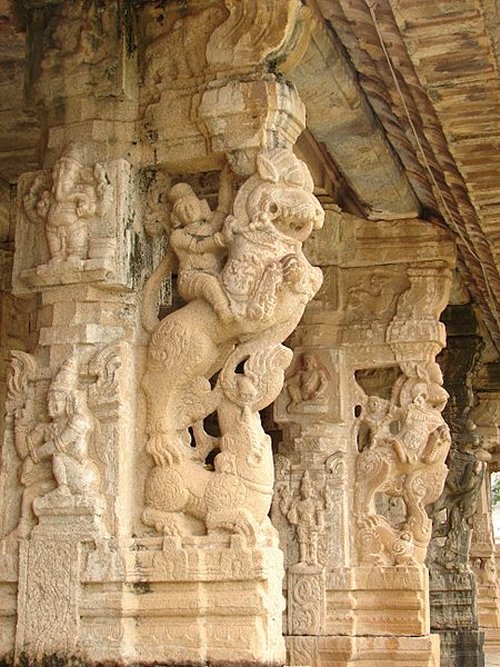Yali – Divine Protector And Guardian Of Temples Warding Off Evil Forces In Hindu Mythology
A. Sutherland - AncientPages.com - A prominent figure of Hindu mythology and a personification of natural forces that can be seen in many South Indian medieval temples is a powerful and strong Yali.
At Meenakshi Amman Temple in Madurai, the cultural capital of Tamil Nadu state, there are as many as one thousand pillars richly covered with carvings of Yali.
 Madurai Meenakshi Amman Temple. Source
Madurai Meenakshi Amman Temple. Source
The Yali - a powerful symbol of protection – can be found in the Tiger Cave, one of the Mahabalipuram rock-cut temples constructed during the reign of King Narasimhavarman I, a great warrior and a devotee of Shiva.
The king is still remembered not for the conquests but for his contributions to the art and architecture of Tamil Nadu.
Descriptions of Yali are very old, and so are references to this mythical creature, often sculpted onto the pillars in temples.
As a personification of natural forces, Yali (also known in Sanskrit as Vyala or Vidala) became prominent particularly in South Indian sculpture in the 16th century.
He was considered to be more powerful than the lion, the tiger, or the elephant. The creature was believed to have organs of horse, lion, and elephant, all together in one.
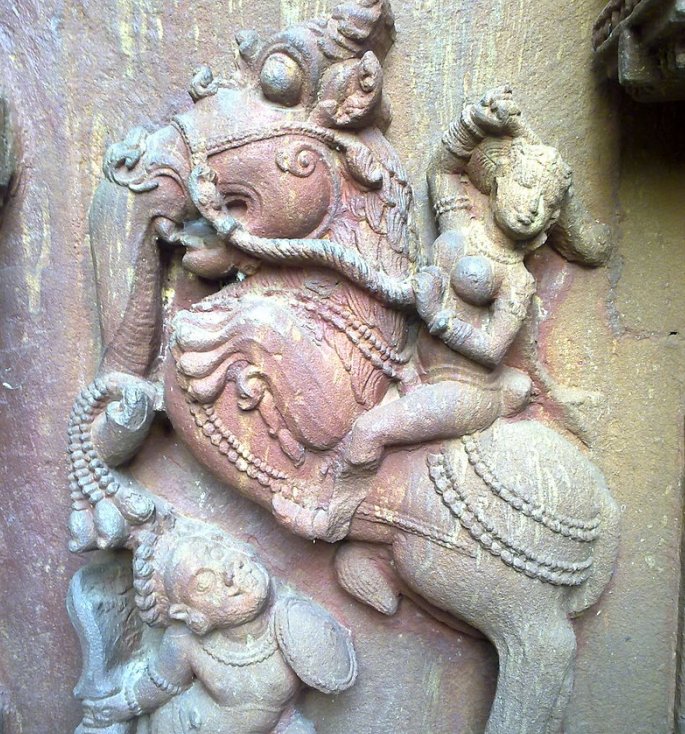
Yali and rider, Mukteshvara Temple, Bhubaneshwar, Odisha state, India. Source
Therefore countless depictions show Yali as part lion, part elephant, and part horse, but also in other similar shapes with a tail of a serpent.
Yali Is Associated With Architecture And Spatial Geometry
According to Vastu Shastra ("science of architecture"), a traditional Indian system of architecture originating in India, there are 16 types of Yalis or Vyalas.
All of them are among the finest sculptures in India, but that’s not all. The mythical Yali’s function is to define space. This function is very important in Vastu Shastra.
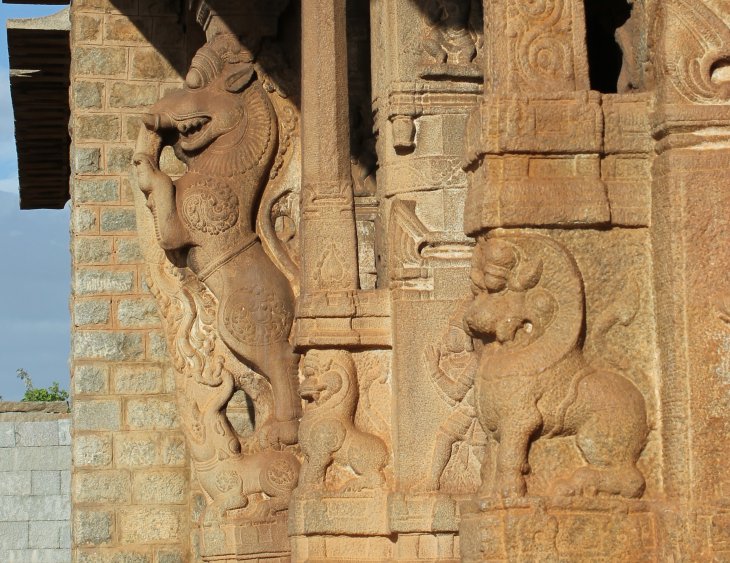
Yali pillars at Ananthasayana temple, Ananthasayanagudi, Karnataka state, India. Source
We are aware of how remarkable is the architecture of India could only be achieved thanks to principles of design, layout, measurements, ground preparation, space arrangement, and spatial geometry. All these principles are mentioned in ancient texts from the Indian subcontinent, where Vastu Shastra is closely associated with traditional Hindu beliefs and in some cases also Buddhist ones.
Yali Linked To A Griffin And A Leogryph
Yali has been sometimes described as a leogryph, commonly depicted in Burmese iconography and Myanmar architecture, especially as a pair of guardians flanking the entrances of Buddhist pagodas and monasteries. Another legendary monster with the head and wings of an eagle and the body of a lion was the griffin.
Yali pillars at the Someshvara temple in India. Credit: Dineshkannambadi - CC BY-SA 3.0
The griffin has been often compared to several ancient mythological creatures, and these include the Lamassu, an Assyrian protective deity, usually depicted with a bull or lion's body, eagle's wings, and human's head.
Lamassu guarded and supported important doorways and entrances in Assyrian palaces, while the powerful Yali sometimes depicted standing on the back of Makara, was a divine protector of temples.
The various carved statues of Yali symbolize protection, intelligence, power, knowledge, speed, wisdom, loyalty, unifying force, predator's nature, mortality, the courage of the warrior, and much more. Most of these characteristics symbolize man's struggle over the elemental and dangerous forces of nature and are clearly expressed by various carvings of the Yali. They have their honorable places in many temples of India.
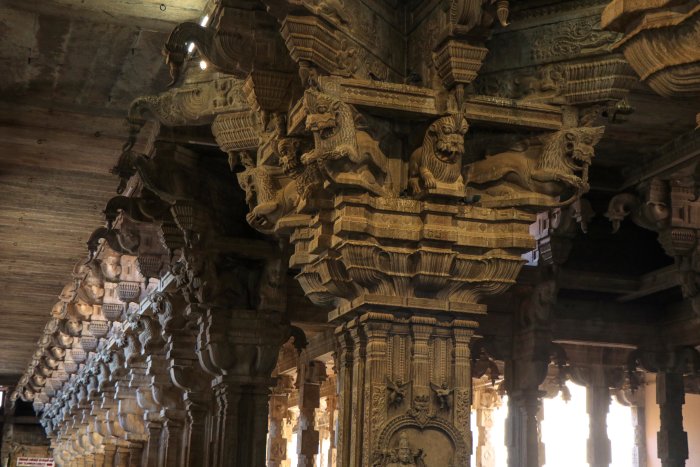
The Yali creature can be found in many Hindu temples. Credit: V.R.Murralinath - Adobe Stock
The old sculptures of the Yali are positioned on both sides of an entranceway to temples. However, in modern times, the carvings of this mysterious creature can be also found as decorations on the entrances of both residential and commercial complexes in the towns of India.
Is it just symbolically or do we perhaps still need to feel protected in some way?
Some believe that the Yali is nothing more than a fantastic legendary hybrid creature in the large pantheon of Hindu gods, goddesses, and animal-like divinities. There is currently no physical evidence to suggest that the Yali is, or ever was a real animal.
Written by – A. Sutherland - AncientPages.com Senior Staff Writer
Copyright © AncientPages.com All rights reserved. This material may not be published, broadcast, rewritten or redistributed in whole or part without the express written permission of AncientPages.com
Expand for referencesMore From Ancient Pages
-
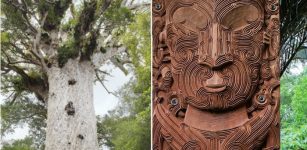 Tāne: Lord Of The Forest Who Brought Three Baskets Of Knowledge To People In Maori Mythology
Featured Stories | Dec 9, 2023
Tāne: Lord Of The Forest Who Brought Three Baskets Of Knowledge To People In Maori Mythology
Featured Stories | Dec 9, 2023 -
 Controversial Artifacts Linked To Cradle Of Civilization In The Americas Result In Scientific Disagreement
Artifacts | May 14, 2018
Controversial Artifacts Linked To Cradle Of Civilization In The Americas Result In Scientific Disagreement
Artifacts | May 14, 2018 -
 Hidden Details In Ancient Egyptian Tomb Paintings Revealed By Chemical Imaging
Featured Stories | Jul 28, 2023
Hidden Details In Ancient Egyptian Tomb Paintings Revealed By Chemical Imaging
Featured Stories | Jul 28, 2023 -
 Did Neanderthals And Modern Humans Meet In The Czech Republic 50,000 Years Ago?
Archaeology | Jun 17, 2017
Did Neanderthals And Modern Humans Meet In The Czech Republic 50,000 Years Ago?
Archaeology | Jun 17, 2017 -
 Something Never-Before-Seen Is Hidden Beneath 15 Giant Viking Burial Mounds Spotted By Radar In Norway
Archaeology | Jan 19, 2021
Something Never-Before-Seen Is Hidden Beneath 15 Giant Viking Burial Mounds Spotted By Radar In Norway
Archaeology | Jan 19, 2021 -
 Secret Ancient Knowledge Of Venus – Controversial Theory And Surprising Discovery – Part 1
Civilizations | Jun 30, 2018
Secret Ancient Knowledge Of Venus – Controversial Theory And Surprising Discovery – Part 1
Civilizations | Jun 30, 2018 -
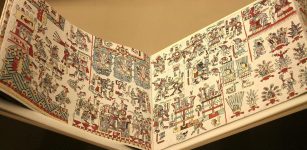 Preserved Mixtec Codices: Codex Zouche-Nuttall – Beautiful ‘Folding Screen Of Historical Events Of Mixtec People Of Oaxaca
Artifacts | Dec 3, 2017
Preserved Mixtec Codices: Codex Zouche-Nuttall – Beautiful ‘Folding Screen Of Historical Events Of Mixtec People Of Oaxaca
Artifacts | Dec 3, 2017 -
 Ancient Mystery Of Peculiar Nail With Six Faces And Six Eyes – Unusual Discovery In Borgholm Castle, Sweden
Artifacts | Jan 8, 2017
Ancient Mystery Of Peculiar Nail With Six Faces And Six Eyes – Unusual Discovery In Borgholm Castle, Sweden
Artifacts | Jan 8, 2017 -
 200,000-Year-Old Grass Bed Discovered In South Africa’s Border Cave
Archaeology | Aug 14, 2020
200,000-Year-Old Grass Bed Discovered In South Africa’s Border Cave
Archaeology | Aug 14, 2020 -
 Amazing Discovery Of A Wakizashi, Japanese Sword In Berlin-Mitte
Archaeology | Aug 28, 2024
Amazing Discovery Of A Wakizashi, Japanese Sword In Berlin-Mitte
Archaeology | Aug 28, 2024 -
 Ancient DNA Unravels The Mystery Of Huge 6,500-Year-Old Cemetery And The Tomb Of A ‘Masculine Woman’ In Normandy, France
Archaeology | May 5, 2022
Ancient DNA Unravels The Mystery Of Huge 6,500-Year-Old Cemetery And The Tomb Of A ‘Masculine Woman’ In Normandy, France
Archaeology | May 5, 2022 -
 Mysterious Biblical Celestial City And Its Connection To The North Star – Nonhuman Hands – Part 1
Biblical Mysteries | Feb 22, 2021
Mysterious Biblical Celestial City And Its Connection To The North Star – Nonhuman Hands – Part 1
Biblical Mysteries | Feb 22, 2021 -
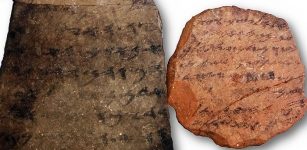 Widespread Literacy In Biblical-Period Kingdom Of Judah – Study Confirms
Archaeology | Sep 11, 2020
Widespread Literacy In Biblical-Period Kingdom Of Judah – Study Confirms
Archaeology | Sep 11, 2020 -
 Never-Before-Seen Face Of A Tattooed Tashtyk Man Hidden Behind A Gypsum Death Mask Revealed
Archaeology | Jul 17, 2020
Never-Before-Seen Face Of A Tattooed Tashtyk Man Hidden Behind A Gypsum Death Mask Revealed
Archaeology | Jul 17, 2020 -
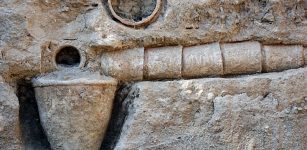 Ancient Aqueduct System Discovered In Boroujerd, Lorestan
News | Sep 16, 2015
Ancient Aqueduct System Discovered In Boroujerd, Lorestan
News | Sep 16, 2015 -
 USC Archeologist Discovers Maya Royal Burial Site
Archaeology | Jan 9, 2016
USC Archeologist Discovers Maya Royal Burial Site
Archaeology | Jan 9, 2016 -
 Moses’ Secret Knowledge Of Superior And Forbidden Technology – Alien Intervention And Events Erased From Historical Records – Part 2
Biblical Mysteries | Sep 24, 2020
Moses’ Secret Knowledge Of Superior And Forbidden Technology – Alien Intervention And Events Erased From Historical Records – Part 2
Biblical Mysteries | Sep 24, 2020 -
 Nail Polish Was Used In 3,000 B.C. – Color Of Fingernails Indicated Social Status In Ancient China And Egypt
Ancient History Facts | Jan 11, 2018
Nail Polish Was Used In 3,000 B.C. – Color Of Fingernails Indicated Social Status In Ancient China And Egypt
Ancient History Facts | Jan 11, 2018 -
 Surprising Evidence Prehistoric People In Survived In The Coldest Regions Of Spain
Archaeology | Oct 6, 2023
Surprising Evidence Prehistoric People In Survived In The Coldest Regions Of Spain
Archaeology | Oct 6, 2023 -
 On This Day In History: American General Benedict Arnold Commits Treason – On Sep 21, 1780
News | Sep 21, 2015
On This Day In History: American General Benedict Arnold Commits Treason – On Sep 21, 1780
News | Sep 21, 2015

